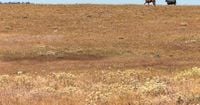Kittitas County and much of central Washington are bracing for a historic water crisis, as unprecedented emergency restrictions are set to take effect on Monday, October 6, 2025. After three consecutive years of punishing drought, the region’s rivers and reservoirs have reached alarmingly low levels, forcing state and local officials to take drastic measures never before seen in the area.
According to the Washington State Department of Ecology, this will be the first time in living memory that curtailments extend to both junior and senior water rights holders—including those with rights dating back before 1905. The sweeping restrictions will impact a wide swath of Kittitas County, including the communities of Ellensburg, Cle Elum, Roslyn, Kittitas, South Cle Elum, and Ronald. While the details and severity of the restrictions will vary by locality, the message from officials is clear: everyone needs to conserve, and fast.
The crisis comes as reservoirs in the Yakima River Basin—spanning 6,100 square miles—are expected to run dry early next week. The Department of Ecology announced that all surface water use, including water drawn from rivers, streams, and reservoirs, will be halted through the end of October. The aim is to conserve what little water remains for fish populations and senior water rights holders, who are typically the last to face such orders.
“We have not experienced a drought like this in over 30 years,” Ria Berns, Ecology’s Water Resources program manager, said in a statement reported by The Seattle Times. The department’s release noted that more than 1,500 water rights holders could see their supply fall short this year, a blow that will be felt by farmers, ranchers, and communities alike.
The impact will be especially acute for those who rely on surface water. Cle Elum, South Cle Elum, and Suncadia, for example, depend heavily on the Yakima River and may have to turn to emergency wells to meet basic needs. Roslyn and Ronald, meanwhile, draw from Domerie Creek. Municipal utilities across the region are enacting contingency plans—tapping supplemental wells where possible, mandating conservation measures, and ramping up public outreach to help curb demand.
Ellensburg and the city of Kittitas, which draw from groundwater, are expected to avoid immediate impacts, but officials warn that no one is truly immune. Groundwater supplies across the American West are also under strain, and the repeated droughts have left little room for complacency.
City leaders are sounding the alarm. Cle Elum Mayor Matthew Lundh put it bluntly: “Cle Elum depends on surface water as our primary source and restrictions place an immediate strain on our system. While our emergency wells provide some relief, they are not a long-term solution. We need our residents to be vigilant about conservation.”
South Cle Elum Mayor Jim DeVere echoed the urgency, saying, “South Cle Elum shares in these challenges, and our community must come together to stretch limited supplies. Every gallon saved helps ensure essential needs can be met. We are actively working to improve our system infrastructure, but we must have water in the pipes first.”
Roslyn Mayor Jeff Adams highlighted the historic nature of the situation: “Roslyn and Ronald are reliant on surface water to meet domestic needs. While we hold senior water rights, this is the first time curtailment has extended to pre-1905 rights basin-wide. We urge residents to understand the gravity of the situation and reduce usage immediately.”
At the county level, Commissioner Laura Osiadacz, Chair of the Kittitas County Board of Commissioners, stressed the need for collective action: “Kittitas County and all of our cities are committed to working together to protect our communities during this critical shortage. We recognize the seriousness of this curtailment and are urging every resident to do their part in conserving water.”
The restrictions will have far-reaching consequences, particularly for the region’s agricultural sector. The Yakima River Basin is not only an important habitat for fish and wildlife but also home to some of Washington’s most fertile cropland. Farmers and ranchers, who have watched their water allocations dwindle over the past several years, now face even greater uncertainty.
“This is the worst of my career, I can tell you that,” Scott Revell, manager of the Roza Irrigation District, told The Seattle Times. The Roza district ran out of water last month, cutting its season short by a full month. Even with early conservation measures and leasing additional water, the district simply could not make its supply last. “The district did all that this year, and still it ran out of water.”
The situation is similarly dire in the Sunnyside Irrigation District, which will shut down on Sunday, October 5, nearly two weeks earlier than usual. District manager David Felman explained that farmers in Sunnyside grow a variety of crops, including forage, hops, and grapes. “This year sits among the worst droughts ever seen by the region,” Felman said. Crop yields have suffered throughout the year, and the loss of end-of-season irrigation means perennial crops will have a tougher time surviving the winter and bouncing back next season. “With these repeated and compounding droughts, farms must suffer through more and more stress. The conditions aren’t sustainable and the parched region will require quite a bit of snow and rain in order to claw back out of the red.”
Unfortunately, the outlook for recovery is bleak. Hydrologists expect snow droughts to hit the region about four years in every decade going forward, making it unlikely that a single wet winter will be enough to restore water levels to normal. Revell said he would settle for even a partial recovery: “Barring a total recovery, I’d be happy with even nominal gains, settling for 70% or 80% of my regular water supply. Compared to 40% that looks pretty good.”
State officials, meanwhile, have expanded the drought emergency order to cover every corner of Washington, with more than a quarter of the area now considered to be in extreme drought according to the U.S. Drought Monitor. The compounding crises of dwindling snowpack, reduced river flows, and shrinking reservoirs have forced communities to consider both short-term fixes and long-term changes to how water is managed and consumed.
For now, the immediate focus is on conservation. Residents are being asked to stop outdoor irrigation, shorten showers, fix leaks, and follow city-specific guidance. Municipalities have set up hotlines and information resources, urging everyone to do their part. The hope is that, by working together, Kittitas County and the broader Yakima River Basin can weather this extraordinary challenge—though the road ahead will be anything but easy.
As the state enters what many officials describe as uncharted territory, the coming weeks will test the resilience and adaptability of communities, farmers, and ecosystems alike. The lessons learned here may well shape how water is managed across the West for years to come.




